The folks at Sativa do a lot of work with maintaining and reinvigorating old varieties for PSR. (Pro Specie Rara, the Swiss seed saver’s organization, see next posting). Most of this work focuses on brassicas, which often suffer from inbreeding depressions, leading to sickly plants and poor yields. By the time inbreeding depression is recognized it is often too late: one cannot simply grow out a large population of the line and save seeds, as the genetics have been bottlenecked by previous small populations (e.g. a home gardener saving seed from too few plants). The only glimmer of hope is to locate other lines of the same variety and cross the lines together — and this is exactly what Friedemann, the vegetable breeder at Sativa, is doing.
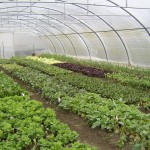


Greehouse production, Brussels sprout de-hybridization, seed crop harvester.
The prime example of this tragic condition is found in the red Brussels sprout variety known as Rubine, still carried by many seed companies throughout Europe and the United States. Rubine has declined over the past several decades and now often fails to produce anything resembling Brussels sprouts. Friedemann recently acquired Rubine from six different sources throughout Europe, with plans to let them all flower together in the hopes that the different lines will bring enough genetics together to reinvigorate the variety — hopefully to the point of producing healthy plants that will produce large sprouts. If this cannot be achieved, he said he will begin work to develop a new red Brussels sprout variety.
Sativa is also involved in Biodynamic breeding projects of a completely different sort than Ute Kirchgasse and Christina Henatsch (see previous posts). Friedemann came to biodynamic vegetable breeding from quite the opposite direction of Christina and Ute. His training and experience is not Anthroposophical, but rather he worked as a vegetable breeder at Hild, a conventional seed company.
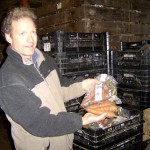


breeder Friedemann, celeriac inspection, snow at Sativa.
It follows, then, that Friedermann has a different approach. In contrast to most of the Biodynamic community, he doesn’t see any problem with the wise use of F1 hybrids for breeding (unless these hybrids are geneticly engineered CMS hybrids). Friedemann doesn’t create hybrid varieties for sale or distribution, but acquires them from other seed companies and then uses these varieties as breeding material. He believes the organic/biodynamic community should utilize the genetic resources and hard work of the conventional community, just as the large seed compaines use the resources of the open-pollinated community in the creation of their hybrids.
The use of F1 hybrids as breeding material for open-pollinated varieties is quite cutting edge and is still very experimental. Because the offspring of F1 hybrids are so unstable, not much work has been done with this “de-hybridization,” especially in regards to out-crossers. But Friedermann insists that the traits and genetics we are after are present in the F1s, as they can be seen in that first generation. The task at hand is integrating as many of those desirable traits as possible into a stable open-pollinated variety.
Brussels sprouts and sweet corn are the two vegetables that are distinctly lacking in open-pollinated varieites for commercial use. The ones that do exist are not suitable for production agriculture, essentially forcing organic growers to grow hybrids. The team at Sativa hopes their work breeding open-pollinated varieties from hybrids will change this.


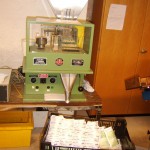

Pear tree, seed cleaner, seed sorter, snow
This dehybridization process is one that requires patience and perseverance, especially when working with outbreeders and biennials such as Brussels sprouts. Friederman will grow out a dozen or more varieties, select the ones that show desirable traits for biodynamic market gardening, and let these plants flower together. He may do this for several generations before even beginning to seclect down to a distinct variety.
But for sweet corn the process is much shorter, and he is quite confident that his OP sugar enhancd sweet corn will be ready for release within the next three to four years. As this will possibly be the first OP sugar enhanced sweet corn on the market, it is a very exciting development.
Aside from his work with sweet corn and Brussels sprouts, Friedemann is also working with onions, carrots, and celeriac. He told us a story from his days at Hild, where they developed a celeriac (celery root) that was pure white on the inside. During this process they discovered that the “unattractive” dark areas on the vegetable hold the most flavor, and the pure white areas are rather insipid. We sampled little bits of both pure white and slightly brown sections of a celeriac and tasted a noticeable difference in flavor and smell. But the celeriac developed by Hild was for processing purposes only, and the flavor was to be added later from a concentrate made from celery seeds. These are the concerns of industrialized food, and so they have become the concern of conventional vegetable breeders.
In his work with carrots, Friedermann is trying to develop good flavored carrots, as are most of the other Biodynamic breeders we met with. But as with most things, his method was quite different from the other breeders. Friedemann is searching for a good juice carrot and is at this point searching for lines to breed from. He grows out several dozen different varieties to evaluate their potential as breeding lines, and once a week processes them in lots for juicing. He reasons that he wants to find the general taste characteristics of the carrots for their juicing qualities, and therefore doesn’t need to sample each carrot individually. After juicing the carrots he sets up a table and invites everyone in the Sativa community to try the juices, and then rate them with a number from one to six, six being the best (the standard Swiss rating method). By gauging the rankings of up to thirty people, Friedermann gets a good idea of the general appeal of each of the varieties.
For carrots, as with all things bred at Sativa and other independent seed companies, flavor is what matters. Breeding vegetables for people instead of industry – how very cutting edge!
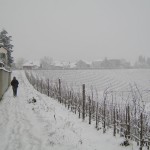
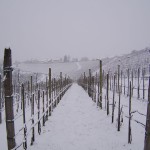

Leave a Reply